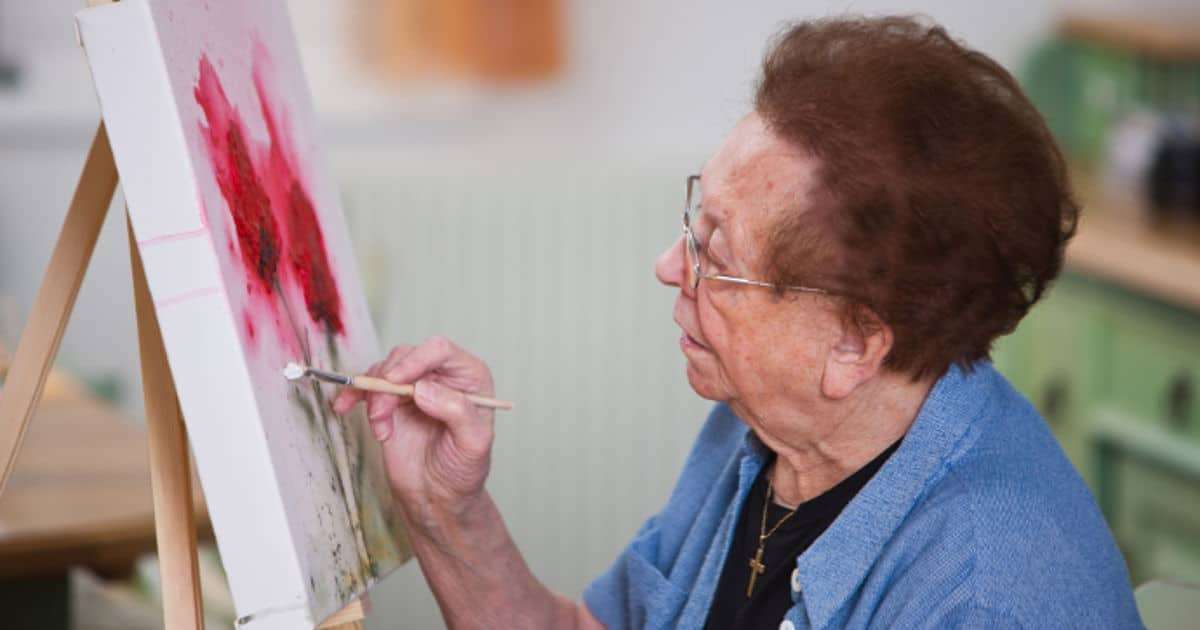
Seniors with Alzheimer’s or dementia often enjoy and benefit from creative activities like art that give the opportunity for non-verbal expression. Creative activities also help reduce agitation and boost mood as well as give a sense of accomplishment and purpose. Vineyard Henderson explains how art therapy for dementia can stimulate the brain and create positive experiences.
Art therapy stimulates the brain
Art projects are a fun, relaxing way for people of all ages to express their creativity, but they’re particularly valuable for seniors with Alzheimer’s or dementia.
Even though nothing will cure dementia, art therapy stimulates the brain in a multitude of ways. It can stir dormant memories and sometimes even encourages speech.
Art can also create a sense of accomplishment and purpose, while also providing an opportunity for nonverbal expression.
Studies have shown that art therapy activities even help boost cognitive function in various areas of the brain and enhance communication, brain function and social interaction in people with dementia.
The benefits of art therapy for dementia are immediately noticeable. Participants show both cognitive and behavioral improvement, plus an increase in confidence.
Advertisement
Create good moments, days, and hours with art therapy
The goal of art therapy is to create “good moments, good hours and good days,” as Ruth Drew, director of family and information services for the Alzheimer’s Association, says.
Art therapy for dementia can spark non-verbal seniors to smile, laugh, speak, or move. It’s incredible to see someone who has extensive impairments come alive again.
The most effective forms of art therapy are ones that are built on personal passions and memories.
There’s no “one size fits all” approach to art therapy. What’s most important is considering your older adult’s current abilities, preferences, and what’s feasible in their living space. The idea is to set them up for success and enjoyment, rather than overwhelm or frustration.
Consider a wide variety of creative activities
Today, popular activities often go beyond the traditional drawing on paper.
Seniors enjoy sculpting with clay or dough, watercolor painting, paint by number projects, charcoal or pencil drawing, making cards, creating jewelry, participating in community art projects, and more.
For example, using modeling clay or dough (we love these bright colors) to create works of art is a wonderful way to engage someone with dementia.
It stimulates the senses, relieves stress, and helps boost hand strength. Many people also feel a great deal of pride and accomplishment in their creations.
Recommended for you:
Guest contributor: Nicole Hanna, Executive Director, Vineyard Henderson. With over 20 years of leadership experience with an expansive skill set in dementia education, training and support, long-term care, nursing, senior fitness and rehabilitation, Nicole brings expertise in operational efficiencies and leadership development, while prioritizing the quality care and happiness of her community.
Image: Aged Care Training Services
This article wasn’t sponsored and doesn’t contain affiliate links. For more information, see How We Make Money.
Art is comparable to magic. Some noble pursuits are necessary to living, but art is what makes us feel alive. It kept us sane through lockdowns due to the COVID-19 pandemic. It served as platforms for societal change. This powerful tool transcends all sorts of limits—even memories that dementia prevents seniors from experiencing in Alzheimer’s senior living.
Moreover, it is no surprise that the benefits of art therapy techniques are incorporated into Alzheimer’s senior living. Art therapy provides the following benefits for seniors living with Alzheimer’s:

-
Inspires Memory
Art is effective. More than the aesthetic, it appeals to our emotions. Perhaps, you’ve seen Van Gogh’s Starry Night, and it stimulated feelings of despair within you. Maybe you’ve heard “La Vie En Rose”, and it made you happy. Through the years, you may not exactly remember the details of the painting or the lyrics of the song, but the feeling it brought you remains vivid. This is because the amygdala (the emotion center of the brain) sits just before the hippocampus (the part responsible for long-term memory retention).
This is the same way that art-based therapies can aid cognition. It communicates through emotions and evokes personal memories. Showing seniors photographs from the past can trigger responses, but asking them to draw from that photo may revive the faintest of emotions and help them reminisce.
-
Increases Brain Stimulation
Can you believe that some dementia patients may not be able to recall memories but can still perform artistic skills such as drawing and playing an instrument? This is linked to the capabilities of procedural or muscle memory, which is further enhanced in art therapy.
Art-based therapies in Alzheimer’s senior living do not eliminate dementia but rather provide interventions that may slow cognitive deterioration. This roots from the theory of brain lateralization. Where areas in the “academic brain” (which manages logic, language, and reasoning) are deteriorated, the “art brain” processes information. It transmits it to the left brain to stimulate memory and thinking. To put it simply, art helps the mind find a new communication path. This is how forms of art, such as melodies and colors, stimulate brain function in areas where semantic memories lose relevance.
-
Allows a New Form of Self-Expression
Anger, sadness, extreme happiness, or even their creativity alone may sometimes be difficult to convey for seniors hindered with dementia. When the usual communication skills are deteriorated, brushes and colors could be the right resort. Creative activities open the way for a whole new form of non-verbal communication. One great example is the artist William Utermolhen, whose artwork documented and visually conveyed his journey through gradual memory loss. When seniors feel frustrated or blissful, art paves the way to new modes of communication where they can freely express themselves. With art as a tool, their feelings are no longer caged.
-
Leads to Social Interactions
Dementia is difficult, because it deprives seniors of basic physiological functions as well as social interactions. Loss of sensations come with its onset. Seniors may often feel detached from their existing surroundings and may become isolated. Since art therapy sessions can rekindle emotional feelings, they also evoke responses. Some seniors who are unable to speak may begin to regain verbal communication, even impulsively. Whether they feel moved or awed with their artworks, simple reactions can sprout into regained communication skills. Soon, these responses can extend up to the people around them during art sessions. In turn, it leads to the briefest interaction.
It revives what dementia mostly deprives them of– intercommunication.
-
Creates a Sense of Achievement and Purpose
Utilizing their creativity can boost a sense of purpose and accomplishment amongst older adults with Alzheimer’s. Whether they are given the freedom to mix watercolors or paint, having something to draw their attention to promotes independence, mastery, and a sense of purpose. In the end, a finished canvas can make them feel accomplished. It gives them a sense of pride, knowing that they can contribute art that can be shared with others. Along with the cognitive benefits of art therapy, it develops confidence and enhances the sense of self amongst seniors.
-
Enhances Mood and General Well-Being
Loneliness, anxiety, and depression often accompany the progression of dementia. When their existing language skills prohibit them from expressing their emotions, seniors become more prone to these behavioral and psychological symptoms. They may also dwell upon crippling anxieties of their degenerative disease or may feel depressed due to tough transitions. This is when art therapy is vital. Through an intuitive graphical presentation, patients are given a more conducive form of venting out their negative emotions. Art also sparks positive emotions. For seniors with no verbal abilities, art can make them smile, laugh, speak, or move. The slightest of reaction despite their impairments is therapeutic. In turn, it fosters well-being and improves the overall quality of life.
-
Boosts Physical Strength and Dexterity
Engaging in Alzheimer’s senior living art activities from the simplest to most complex promotes mobility. Practicing art stimulates the parietal lobe, which is responsible for fine motor functions. Through exercising their hands, seniors maintain their hand-brain interaction, which improves motor skills and coordination. No matter the amount and extent of physical movement, constant mobility retains muscle function and promotes overall physical strength.

-
Art Makes Fun Moments
For seniors under memory care facilities, art therapy sessions make a great escape from sometimes dull living triggered by their incapacities. Whether they are suffering from other chronic illnesses or memory deterioration alone, a change of environment and the beauty of art can provide therapeutic effects. Opportunities through pottery, crafting, painting, drawing, or even playing musical instruments touch the heart and trigger feelings that the brain had long forgotten. Art therapy allows seniors to indulge in the healing benefits of aesthetics.
Key Takeaway
Battling Alzheimer’s may be overwhelming for seniors and their loved ones. Fortunately, Sabal Palms assisted living and memory care is dedicated to ensuring that your older loved ones are well-catered to in this journey. Through the incorporation art therapy in, seniors are allowed to experience their golden years through beauty.




